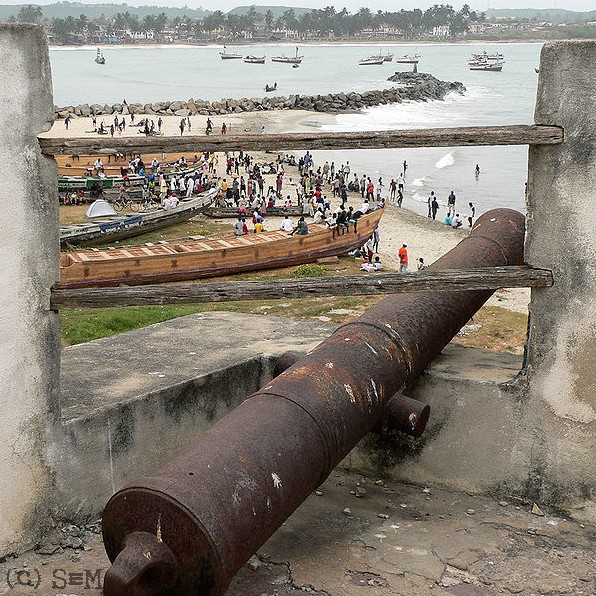|
Day Tour: Elmina Castle |
Coordinates: 5° 5′ N, 1° 21′ W |
|
Britain granted the Gold Coast its independence in 1957, and control of the castle was transferred to the nation formed out of the colony, present-day Ghana. Today it is a popular historical site, and was a major filming location for Werner Herzog's Cobra Verde. The castle is recognized by UNESCO as a World Heritage Site. The people living along the West African coast at Elmina around the fifteenth century were presumably Fante. The Fante ethnicity bears an uncertain relationship to "Akan," itself a word connoting originality from the root word, "kan", to be first or original. Among their ancestors were merchants and miners trading gold into the Mediterranean and Near Eastern worlds from medieval times. The ancestors of the Akan-speakers of the forests however undoubtedly came from north of the forest.
West Africans nurtured ancient connections to other parts of the world. Common metals trade, iconic artistic forms, and agricultural borrowing show that trans-Saharn and regional coastal connections thrived. The Portuguese in 1471 were the first Europeans to visit the Gold Coast as such, but not necessarily the first sailors to reach the port. The Portuguese first reached what became known as the Gold Coast in 1471. Prince Henry the Navigator first sent ships to explore the African coast in 1418. The Portuguese had several motives for voyaging south. They were attracted by rumors of fertile African lands that were rich in gold and ivory. They also sought a southern route to India so as to circumvent Arab traders and establish direct trade with Asia. In line with the strong religious sentiments of the time, another focus of the Portuguese was Christian proselitism. They also sought to form an alliance with the legendary Prester John, who was believed to be the leader of a great Christian nation somewhere in Africa.
By the seventeenth century, most trade in West Africa concentrated on the sale of slaves. São Jorge da Mina played a significant part in the Atlantic Slave Trade. The castle acted as a depot where slaves were bought in bartering fashion from local African chiefs and kings. The slaves, often captured in the African interior by the slave-catchers of coastal tribes, were sold to Portuguese traders in exchange for goods such as textiles and horses. The slaves were held captive in the castle before exiting through the castle’s infamous “Door of No Return” to be transported and resold in newly colonized Brazil and other Portuguese colonies.
|
 These
motives prompted the Portuguese to develop the
Guinea trade. They made gradual progress down the
African coast, each voyage reaching a point further
along than the last. After fifty years of coastal
exploration, the Portuguese finally reached Elmina
in 1471, during the reign of King Afonso V. However,
because Portuguese royalty had lost interest in
African exploration as a result of meager returns,
the Guinea trade was put under the oversight of the
Portuguese trader, Fernão Gomes. Upon reaching
present day Elmina, Gomes discovered a thriving gold
trade already established among the natives and
visiting Arab and Berber traders. He established his
own trading post, and it became known to the
Portuguese as “A Mina” (the Mine) because of the
gold that could be found there.
These
motives prompted the Portuguese to develop the
Guinea trade. They made gradual progress down the
African coast, each voyage reaching a point further
along than the last. After fifty years of coastal
exploration, the Portuguese finally reached Elmina
in 1471, during the reign of King Afonso V. However,
because Portuguese royalty had lost interest in
African exploration as a result of meager returns,
the Guinea trade was put under the oversight of the
Portuguese trader, Fernão Gomes. Upon reaching
present day Elmina, Gomes discovered a thriving gold
trade already established among the natives and
visiting Arab and Berber traders. He established his
own trading post, and it became known to the
Portuguese as “A Mina” (the Mine) because of the
gold that could be found there.